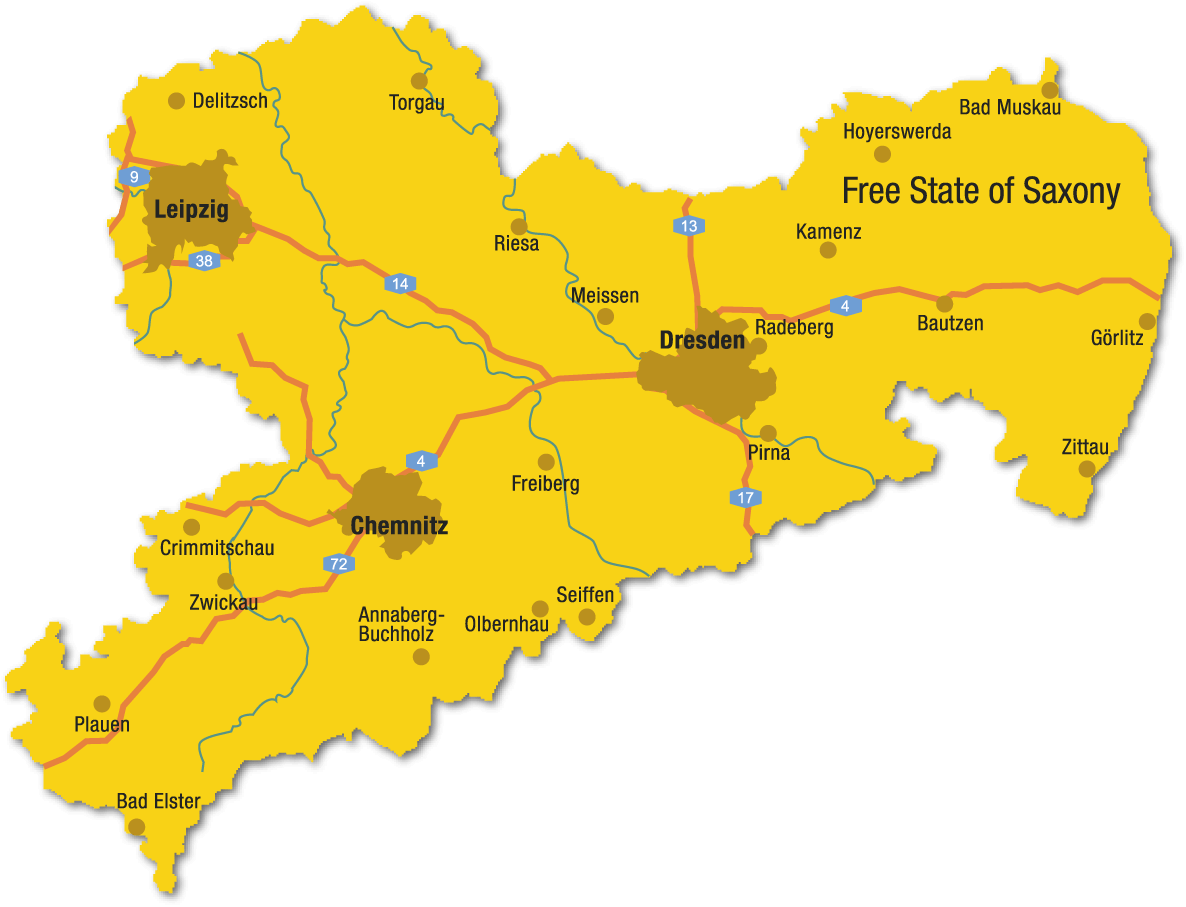The Saxon alchemists actually wanted to make gold artificially and happened to invent porcelain by sheer coincidence. The way there was anything but easy. Embark on a tour following the traces of how the »White Gold« – one of Augustus the Strong’s greatest passions – was discovered.

Koenigstein Fortress (A) – Place of captivity of alchemist Johann Friedrich Boettger
The mountain fortress in Saxon Switzerland is one of the three places where alchemist Johann Friedrich Boettger was held captive by Augustus the Strong. From 1706 to 1707, Saxony was at war with Sweden in the so-called Northern War. Swedish King Charles XII marched his army towards Dresden, so that Augustus had his alleged goldmaker Boettger locked away.
Continue to Station B – Dresden Fortress, approx. 35 km
The casemates that have been preserved underneath Bruehl’s Terrace are one of the few remaining testimonies to the Dresden fortification. In one part of this old fortification, the Virgin Bastion, Ehrenfried Walther von Tschirnhaus and Johann Friedrich Boettger succeeded on January 15, 1708 in inventing the white European hard-paste porcelain. Gottfried Pabst von Ohain and miners and smelters from the Freiberg mining territory contributed to that success.
- Details on Dresden Fortress
Continue to Station C – The Dresden Zwinger, approx. 1 km
Dresden Fortress (B) – the birthplace of the European porcelain

The Dresden Zwinger (C) – the porcelain collection of Augustus the Strong
The Dresden Zwinger was erected by Matthaeus Daniel Poeppelmann as an orangery for Augustus the Strong and was later extended to serve as a venue for festivities. Its galleries and pavilions also accommodates the special ceramic collection, which is of the highest quality and the most extensive in the world – the Porcelain Collection. Apart from porcelain from the Far East dating from the 17th and 18th centuries, it mainly includes an extraordinary inventory of the early Meissen porcelain.
- Details on the Dresden Zwinger
Continue to Station D - Meissen Albrechtsburg Castle, ca. 26 kmDresden Zwinger
Meissen Albrechtsburg Castle (D) – the initial production site of the Porcelain Manufactory
In 1705, Germany’s oldest palace building was a shelter to hold alchemist Johann Friedrich Boettger captive and served the Royal Meissen Porcelain Manufactory from 1710 until 1863 as its first production site for the »White Gold«. After the manufactory had moved out, Paul Kiessling created two of the most famous murals of the castle in the »Boettger Room« in 1875.
A large area in the new permanent exhibition reports today about the era of the manufactory.
- Details on Meissen Albrechtsburg Castle
Continue to Station E - Staatliche Porzellan Manufaktur Meissen GmbH, approx. 2 km


The Meissen porcelain manufactory moved into what is still today its manufacturing site in Meissen Triebischtal valley in 1863. In its showroom workshops, visitors can gain an insight into its production. In the showroom hall, a wide range of historical porcelain is on display. Special exhibitions of changing themes also relate to contemporary porcelain design.
- Details on the Porcelain Manufactory
Continue to Station F – The Saxon Superior Mining Office, Freiberg, approx. 34 km
Staatliche Porzellan-Manufaktur Meissen GmbH (E) – manufacturing today
The Superior Mining Office, Freiberg (F) – a mining counsel sets the points for inventing the porcelain
Beside Ehrenfried Walther von Tschirnhaus and Johann Friedrich Boettger, the Freiberg Mining Counsel Gottfried Pabst von Ohain (1656 – 1729) was to a considerable extent part of inventing the porcelain. In 1701, Augustus the Strong called him to come to Dresden to give his opinion on Boettger’s alchemical gold experiments. Mining Counsel Pabst could merely acknowledge the impossibility of success and was, under von Tschirnhaus’ direction, involved in the trials for making porcelain. His detailed knowledge of the smelting furnaces in Saxon mining advanced the development of the furnace technology. After Pabst had suggested to use »White Earth« from Aue as a base ingredient and recommended alabaster as a fluxing agent, Tschirnhaus and Boettger succeeded in 1708 in manufacturing the first European porcelain.
- Details on the Superior Mining Office, Freiberg
Continue to Station G - St. Andreas, approx. 85 km
From 1711 to 1851, the »White Earth Mine« at the Heidelsberg mountain in Aue supplied the major part of the kaolin for the manufacture of the Meissen Porcelain. As this mine belonged to the Schnorr von Carolsfeld family, the kaolin was also termed »Schnorr’s Earth«.
The entrepreneurial Schnorr family held considerable property in the Ore Mountain mining. Apart from the largest hammer mills in Carlsfeld and Aue, they also owned silver and cobalt mines. The kaolin at the Heidelsberg mountain had been discovered in 1698. Today the St. Andreas Mine is one of the selected sites for the envisaged candidacy to be awarded with the UNESCO world heritage title »Ore Mountains Mining Region«.
- Details on the »White Earth Mine« St. Andreas
Continue to Station H - Schneeberg, Exhibition Mine »Treasure Trove White Stage«, approx. 6 km
Aue, “White Earth Mine” St. Andreas (G) – source for kaolin
The blue of Delft tiles, the blue in Venetian glass and even the blue on Chinese porcelain originates from the Electoral Saxon blue-dye works around Schlema and Schneeberg. No doubt that the blue crossed swords, world-famous trademark of the Meissen porcelain, have been painted with the cobalt blue from Schneeberg.
Today’s exhibition mine »Treasure Trove White Stag« is located on the premises of Bergsicherung Schneeberg GmbH. The mine was first mentioned under that name in 1654. The ‘Hut und Treibehaus’ built in 1851 and visible from afar was gradually reconstructed true to the historical original between 1994 and 1996.
- Details on the Exhibition Mine »Treasure Trove White Stag«
